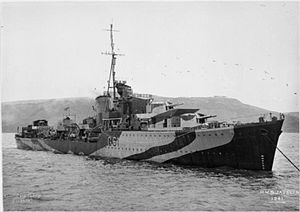Battle of the Tripoli Convoy
| Battle off Zuwarah | |||||||
|---|---|---|---|---|---|---|---|
| Part of the Battle of the Mediterranean of World War II | |||||||
 HMS Javelin |
|||||||
|
|||||||
| Belligerents | |||||||
|
|
|
||||||
| Commanders and leaders | |||||||
| Commander Michael Townsend | Lieutenant Giuseppe Di Bartolo † | ||||||
| Strength | |||||||
| 2 destroyers | 4 Minesweepers 7 small auxiliary vessels |
||||||
| Casualties and losses | |||||||
| 7 wounded | 4 minesweepers sunk Entire flotilla sunk 180 killed |
||||||
The Battle off Zuwarah was a World War II naval battle which took place on the night of 19 January 1943 in Libyan waters between British and Italian forces. The battle ended with the complete destruction of an Italian flotilla of small minesweepers and auxiliary vessels evacuating Tripoli.
The British Royal Naval destroyers HMS Kelvin and HMS Javelin were patrolling the area off Zuwarah, Libya. Part of a task force, their mission was to cut off the escape route of the last Italian ships fleeing from Tripoli, which would be conquered by Allied troops on 23 January 1943. Kelvin and HMS Nubian had forced the Italian torpedo boat Perseo to retire damaged and then sunk the 4,537 ton D'Annunzio, a merchant ship fleeing from Tripoli, on 15 January 1943.
On the night of 19/20 January 1943 Javelin's Type 271 radar detected a number of ships heading directly towards the Tunisian coast, coming from Tripoli. It was the Tripoli minesweeping flotilla, which had been ordered to leave the city and evacuate to Tunisia and then to Italy to avoid capture. The flotilla, under the command of Lieutenant Giuseppe Di Bartolo, was made up of four small minesweeping tugs (RD 31, RD 36, RD 37 and RD 39, of which RD 36 and 37 were crewed with Italian Guardia di Finanza personnel); the trawler Scorfano (the largest ship in the convoy); the small tanker Irma; the auxiliary minesweepers DM 12 Guglielmo Marconi (a requisitioned brigantine); R 26 Angelo Musco and R 224 Cinzia (two former fishing vessels); the auxiliary patrol vessel V 66 Astrea (a motor sailing vessel); and the pump boat S. Barbara (towed by the Scorfano).
...
Wikipedia
